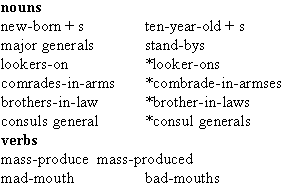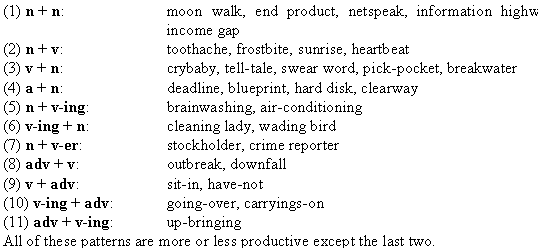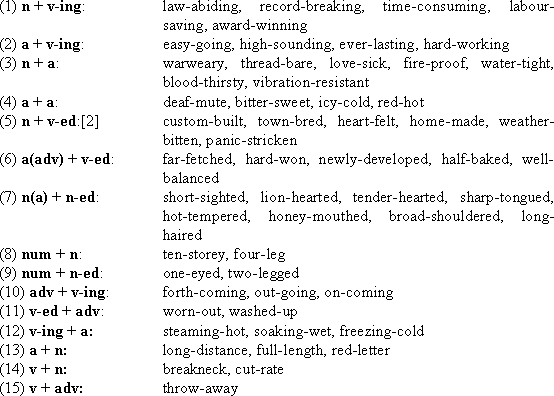|
|
|
4.2
Compounding
Compounding,
also called composition, is the formation of new words by joining
two or more stems. Words formed in this way are called compounds.
So a compound is a 'lexical unit consisting of more than one stem and
functioning both grammatically and semantically as a single word'. Silkworm
and honey-bee are compounds; so are tear gas and easy
chair. These examples show that compounds can be written solid
(silkworm), hyphenated (honey-bee) and open
(tear gas and easy chair). As open compounds are the same
in form as free phrases, what is the dividing line between them?
Solid:
breakneck, flowerpot
Hyphenated:
honey-bee, flower-pot
Open:
easy chair, flower pot
¢¢¢
Characteristics
4.2.1
Characteristics of Compounds
Compounds
differ from free phrases in the following three aspects.
1.
Phonetic features. In compounds the word stress usually occurs
on the first element whereas in noun phrases the second element is generally
stressed if there is only one stress. In cases of two stresses, the compound
has the primary stress on the first element and the secondary stress,
if any, on the second whereas the opposite is true of free phrases, e.g.

But
these stress patterns of compounds are not absolute. Sometimes, the primary
stress may also fall on the second element as in ash-`blonde and
bottle-`green as well as in bining-form
compounds, socio-lin`guistic, psycho-a`nalysis. Therefore,
this is not always reliable.
2.
Semantic features. Compounds are different from free phrases in
semantic unity. Every compound should express a single idea just as one
word. For instance, a green hand is an 'inexperienced person',
not a hand that is green in colour; red meat refers to 'beef' or
'lamb' rather than any meat that is red in colour; hot dog is by
no means a dog that is hot, but a typical American sausage in between
two pieces of bread. The meanings of such examples cannot be easily inferred
from the two components of the compounds.
Nevertheless,
a lot of compounds are transparent, that is the meaning can be inferred
from the separate elements of compounds. Consider the following random
examples: disaster-related, flower pot, washing machine, dumb show,
scarlet fever and many others. But the two elements are inseparable
and the change of the element would result in the loss of the original
identity. Look at the following examples;
bird
brain black
mail
hot
potato dog
days
the
youngest daughter
that
white darkhorse
a
bright darkroom
3.
Grammatical features. A compound tends to play a single grammatical
role in a sentence, for example, a verb, a noun, or an adjective. Bad-mouth
used as a verb can take the third person singular -s and the past tense
marker -ed, e.g. 'He bad-mouthed me.' Compound nouns show their
plural forms by taking inflectional -s at the end, e.g. new-borns,
three-year-olds, will-o'-the-wisps, major generals. Of course, there
are exceptions such as brothers-in-law, lookers-on. In spite of
this their single grammatical role is apparent.

In
adjective-noun compounds, the adjective element cannot take inflectional
suffixes, for example:

¢¢¢
Formation
4.2.2
Formation of Compounds
Compounding
can take place within any of the word classes, e.g. prepositions as without,
throughout; conjunctions as however, moreover; pronouns
as oneself, somebody, but the productive ones are nouns and adjectives
followed by verbs to a much lesser extent. Most compounds consist of only
two stems but are formed on a rich variety of patterns and the internal
grammatical relationships within the words are considerably complex. This
section will focus on the three major classes of compounds.
1.
Noun compounds

2.
Adjective compounds

Of
these patterns, (1), (3) and (5) are very productive.
3.
Verb compounds
Verb
compounds are not as common as the other two classes. The limited number
of verbs are created either through conversion or backformation (See Conversion
and Backformation for details).
Through
conversion

Through
backformation

As
shown by the examples, back-formed verb compounds are formed mainly by
dropping the suffixes: -er, -ing, -ion, etc.
The
discussion so far is restricted to two-stem compounds. There are many
compounds which contain more than two stems. In fact, these are free phrases
or idioms but are joined together by hyphens to form a single unit, for
example, stay-at-home, forget-me-not, dog-in-the-manger. This probably
accounts for the high productivity of compounding. When a word which is
needed does not exist, all one has to do is choose an expression or even
a sentence and hyphenate the words. This is the common practice of journalists
and popular writers. In mass media we may often come across expressions
like a pain-in-stomach gesture, ahead-of-schedule general
election, too-eager-not-to-lose champion, a middle-of-the-road
politician, and round-the-clock discussion.
Multistem
words
stay-at-home
forget-me-not
dog-in-the-manger
pain-in-stomach
gesture
ahead-of-schedule
general election
too-eager-not-to-lose
champion
a
middle-of-the-road politician
round-the-clock
discussion.
devil-may-care
twist-and-turn
waist
paint-yourself-dress
A
spirited discussion springs up between a young girl who says that women
had outgrown the jumping-on-a-chair-at-the-sight-of-a-mouse era
and a major who says that they haven't.
|